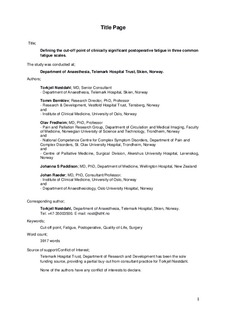| dc.contributor.author | Nøstdal, Torkjell | |
| dc.contributor.author | Bernklev, Tomm | |
| dc.contributor.author | Fredheim, Olav Magnus | |
| dc.contributor.author | Paddison, Johanna S. | |
| dc.contributor.author | Ræder, Johan | |
| dc.date.accessioned | 2019-05-09T11:02:15Z | |
| dc.date.available | 2019-05-09T11:02:15Z | |
| dc.date.created | 2018-12-07T11:12:10Z | |
| dc.date.issued | 2018 | |
| dc.identifier.citation | Quality of Life Research. 2018, . | nb_NO |
| dc.identifier.issn | 0962-9343 | |
| dc.identifier.uri | http://hdl.handle.net/11250/2597103 | |
| dc.description.abstract | Purpose Postoperative fatigue (POF) is an often underestimated problem after surgery. Studies on POF often report fatigue scores without relating this to the clinical relevance for the patients. The aim of this study was to define the cut-off point for clinically significant POF in three commonly applied fatigue scales; the Postoperative Fatigue Scale, Christensen’s Fatigue Scale, and the Chalder Fatigue Questionnaire. The identification of cut-off points will make it possible to indicate whether statistically significant findings of increased fatigue are of clinical relevance. Methods We combined data from day 0 (pre-operatively) and day 1, 3, 6, and 30 after surgery in two fatigue-related studies with 442 patients. In order to define clinically significant fatigue, a key question was added in each questionnaire; “Given your current description of fatigue, would you say it has been of considerable significance to you?”; “Yes/No”. We analysed each scale’s ability to identify clinically significant fatigue, by performing receiver-operating characteristics (ROC) analyses, and calculated the optimal cut-off point between Sensitivity and Specificity. Results The average weighted cut-off point for clinically significant POF when measured with the Postoperative Fatigue Scale was ≥ 50 (scale range 0–100), with Christensen’s Fatigue Scale ≥ 6 (scale range 1–10) and with the Chalder Fatigue Questionnaire ≥ 16 (scale range 0–33). Conclusion In three commonly used fatigue scales, we have identified cut-off points for clinically significant fatigue among patients recovering from surgery. This can be particularly valuable for diagnostic purposes and in treatment evaluation. Further, it may be possible to analyse and review data from earlier studies in light of clinical relevance. | nb_NO |
| dc.language.iso | eng | nb_NO |
| dc.publisher | Springer | nb_NO |
| dc.title | Defining the cut-off point of clinically significant postoperative fatigue in three common fatigue scales | nb_NO |
| dc.type | Journal article | nb_NO |
| dc.type | Peer reviewed | nb_NO |
| dc.description.version | acceptedVersion | nb_NO |
| dc.source.pagenumber | 13 | nb_NO |
| dc.source.journal | Quality of Life Research | nb_NO |
| dc.identifier.doi | 10.1007/s11136-018-2068-0 | |
| dc.identifier.cristin | 1640268 | |
| dc.description.localcode | This is a post-peer-review, pre-copyedit version of an article published in [Quality of Life Research ] Locked until 30.11.2019 due to copyright restrictions. The final authenticated version is available online at: http://dx.doi.org/[10.1007/s11136-018-2068-0] | nb_NO |
| cristin.unitcode | 194,65,25,0 | |
| cristin.unitname | Institutt for sirkulasjon og bildediagnostikk | |
| cristin.ispublished | true | |
| cristin.fulltext | original | |
| cristin.qualitycode | 2 | |
